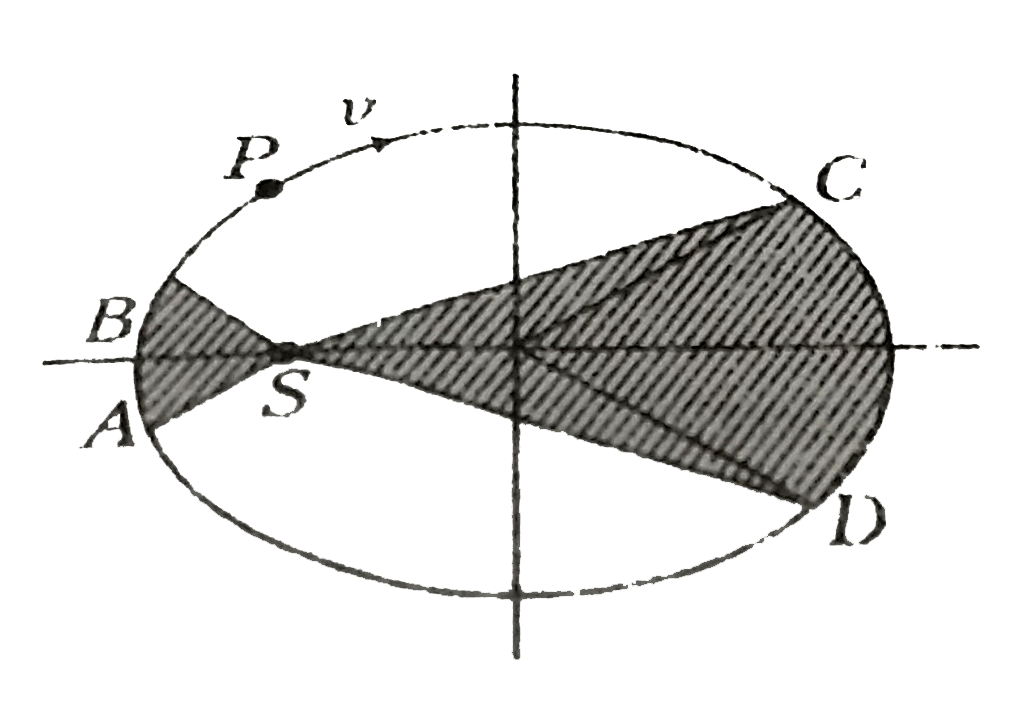Figure shows the orbit of a planet P round the sun S. AB and CD are the minor and major axed of the ellipse.

If t1 is the time taken by the planet to travel along ACB and t2 the time along BDA, then
t1=t2
t1>t2
t1<t2
nothing can be concluded
The correct Answer is:B
Since arial velocity is constant so t1>t2.
Topper's Solved these Questions
- BOOK - BANSALCHAPTER - GRAVITATIONEXERCISE - EXERCISE -2 [Reasoning Type]5videos
GRAVITATION
- BOOK - BANSALCHAPTER - GRAVITATIONEXERCISE - EXERCISE -2 [Multiple Cprrect Choice Type]15videos
GRAVITATION
- BOOK - BANSALCHAPTER - GRAVITATIONEXERCISE - EXERCISE -1 [Single Correct Choice Type]21videos
GRAVITATION
- BOOK - BANSALCHAPTER - CENTRE OF MASS & MOMENTUM CONSERVATIONEXERCISE - EXERCISE-4 (SECTION-B) (JEE-ADVANCED Previous Year Questions)8videos
CENTRE OF MASS & MOMENTUM CONSERVATION
- BOOK - BANSALCHAPTER - HEAT TRANSFEREXERCISE - Exercise89videos
HEAT TRANSFER
Similar Questions
The figure shows elliptical orbit of a plant P about the sun S. The shaded area CSD is twice tha shaded area ASB. If t1 is the time taken by the planet to move from C to D and t2 is the time to move from A to B, determine the ratio t1/t2
 View Solution
View SolutionThe given figure shows the elliptical orbit of a planet m about the sun S. If t1 is the time taken by the planet of move from C to D and t2 is the time taken by the planet to move from A to B, then the relation between t1andt2 is [Given, area SCD = 2 (area SAB)]
 View Solution
View Solution
Knowledge Check
- Question 1 - Select One
Figure shows the orbit of a planet P round the sun S. AB and CD are the minor and major axed of the ellipse.

If U is the potential energy and K kinetic energy then |U|>|K| atAonly DBonly CCboth D&CDneither Dnor C - Question 2 - Select One
_S01_025_Q01.png)
The figure shows elliptical orbit of a planet m about the sun S. the shaded area SCD is twice the shaded area SAB. If t1 be the time for the planet to move from C to D and t2 is the time to move from A to B, then:At1=t2Bt1=8t2Ct1=4t2Dt1=2t2 - Question 3 - Select One
_S01_025_Q01.png)
The figure shows elliptical orbit of a planet m about the sun S. the shaded area SCD is twice the shaded area SAB. If t1 be the time for the planet to move from C to D and t2 is the time to move from A to B, then:At1=4t2Bt1=2t2Ct1=t2Dt1>t2
The figure shows the motion of a planet around the sun in an elliptical orbit with the sun at one focus. The shaded area SAB is twice that of SCD. If t1andt2 are the times taken by the planet to move from A to B and C to D respectively, then
 View Solution
View Solution_S01_025_Q01.png)
The figure shows elliptical orbit of a planet m about the sun S. the shaded area SCD is twice the shaded area SAB. If t1 be the time for the planet to move from C to D and t2 is the time to move from A to B, then:View SolutionFigure shows the elipticla path of a planet about the sun. The two shaded parts have equal area. If t1andt2 be the tim taken by the planet to go from a to b and from c to d respectively
View Solution_E01_134_Q01.png)
Figure elliptical path abed of a planet around the sun S such that the area of Delta csa is 14 the area of the ellipse, (see figure) with db as the semimajor axis, and ca as the semiminor axis if t1 is the time taken for planet to go over path abc and t2 for path taken over cda then:View SolutionFigure shows the motion of a planet around the Sun S in an elliptical orbit with the Sun at the focus. The shaded areas A and B are also shown in the figure which can be assumed to be equal. If t1 and t2 represent the time taken for the planet to move from a to b and c to d, respectively then
 View Solution
View Solution

